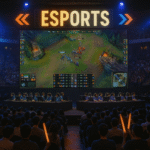The San Diego Chargers had one of the NFL’s most passionate fanbases — until they moved to Los Angeles in 2017. Within two years, merchandise sales dropped 67%. Season ticket renewals? Down 82%. The team that once sold out 70,000-seat stadiums now struggles to fill 27,000 seats with actual fans rather than opposing team supporters. This isn’t just a relocation story — it’s a masterclass in how decades of fan loyalty can evaporate overnight when organizations forget that engagement isn’t transactional, it’s emotional.
Modern sports face an engagement crisis that makes the Chargers’ exodus look like a minor hiccup. Streaming services fragment attention spans. Social media creates infinite entertainment alternatives. Younger demographics view traditional sports as slow, outdated, and irrelevant to their digital lives. The old playbook — win games, sell tickets, broadcast on TV — doesn’t work when fans have 10,000 other entertainment options literally in their pocket.
When loyalty dies — the brutal reality of losing lifelong fans in modern sports
Fan loyalty isn’t inherited anymore — it’s earned daily in an attention economy where sports compete with Netflix, TikTok, and video games for every precious minute of engagement. The most sobering statistic in sports business? Average fan attention spans have dropped from 12 minutes to 8 seconds for passive content consumption. That means teams have the length of a single play to capture interest before fans scroll to something else.
Consider what happened to baseball, America’s supposed pastime. MLB attendance peaked in 2007 at 79.5 million fans annually. By 2023, it had dropped to 70.8 million despite population growth and stadium improvements. The problem isn’t the product — playoff games still deliver incredible drama. The problem is that three-hour games don’t fit modern consumption patterns, and baseball’s leadership spent years ignoring this reality.
The most devastating fan losses aren’t dramatic departures — they’re gradual disconnections that happen imperceptibly until suddenly entire demographics have vanished. The NBA lost 45% of its television viewership among viewers aged 18-34 between 2012 and 2023. These aren’t fans switching to different teams; they’re abandoning the sport entirely for entertainment options that better match their preferences and lifestyles.
The generational preference shift
Generation Z consumes sports completely differently than previous generations. They want highlights, not full games. Interactive experiences, not passive viewing. Authentic personalities, not corporate messaging. Teams that understood this early — like the Sacramento Kings with their social media innovation — maintained young fan engagement while others watched their demographics age out without replacement.
The subscription fatigue factor
Modern fans need multiple streaming subscriptions, cable packages, and premium memberships just to follow their favorite teams. The average dedicated NFL fan pays $200+ monthly across various platforms to access all their team’s content. This financial burden has created a new category: displaced fans who remain emotionally invested but can’t afford consistent engagement.
Social media’s double-edged impact
Platforms like Twitter and Instagram allow unprecedented access to athletes and behind-the-scenes content, creating deeper connections than ever possible. But they also amplify every controversy, criticism, and negative storyline. Teams that mismanage social media crises can lose thousands of fans in hours, not seasons.
The authenticity demand
Modern fans possess sophisticated media literacy and immediately recognize manufactured content. Traditional sports marketing — polished commercials, scripted interviews, corporate messaging — feels inauthentic to audiences raised on unfiltered social media content. Teams that haven’t adapted their communication styles struggle to maintain credibility with younger demographics.
Digital transformation — how smart teams build unbreakable fan connections
The most successful sports organizations have stopped thinking like sports teams and started operating like media companies, tech startups, and entertainment brands simultaneously. This transformation requires completely reimagining fan relationships from transactional exchanges to ongoing digital partnerships.
Manchester City’s digital strategy exemplifies this evolution. They don’t just broadcast matches — they create 24/7 content ecosystems that keep fans engaged year-round. Training session highlights, player lifestyle content, tactical analysis videos, and interactive fan challenges generate millions of daily engagements that extend far beyond match days.
The Golden State Warriors revolutionized arena technology by treating their new Chase Center as a giant smartphone rather than a traditional venue. Every seat includes charging stations, high-speed WiFi, and integrated ordering systems. Fans can order food, upgrade seats, and access exclusive content without missing game action. This isn’t just convenience — it’s digital integration that makes attending games feel natural rather than technologically jarring.
Personalization at scale
Modern CRM systems allow teams to create individualized fan experiences for millions of supporters simultaneously. The Boston Celtics use data analytics to send personalized content based on fan behavior: casual supporters receive highlight reels, statistical enthusiasts get advanced analytics, and social fans receive behind-the-scenes content. This customization makes every fan feel individually valued rather than mass-marketed.
Interactive content strategies
Successful teams create participatory rather than passive content experiences. The Philadelphia Eagles’ “Inside the Birds” podcast allows fans to submit questions that get answered by coaches and players. Fantasy integration lets fans feel personally invested in statistical outcomes. Prediction games and trivia contests transform passive viewing into active participation.
Multi-platform presence optimization
Elite sports organizations maintain consistent but platform-appropriate presence across 8-12 different social media and digital platforms. Content strategies adapt to each platform’s strengths: Instagram for visual storytelling, TikTok for viral moments, Twitter for real-time updates, YouTube for long-form content, and emerging platforms for experimental engagement.
Data-driven decision making
Advanced analytics now track fan engagement with the same precision as player performance statistics. Teams monitor which content generates the most interaction, when fans are most likely to engage, and what factors predict long-term loyalty. This data-driven approach allows continuous optimization of engagement strategies based on measurable results rather than intuition.
The experience economy — creating moments that turn casual viewers into die-hard supporters
Modern fan engagement transcends entertainment — it’s about creating meaningful experiences that become part of personal identity and lifelong memories. The most successful sports organizations understand that fans don’t just want to watch games; they want to feel like participants in something larger than themselves.
The Seattle Seahawks created the “12th Man” culture not through marketing campaigns but by systematically designing experiences that made fans feel essential to team success. Stadium acoustics were optimized to amplify crowd noise. Fans received education about when their noise impact was most crucial. Player celebrations specifically acknowledged fan contributions. This wasn’t just branding — it was experiential design that made fans feel like legitimate team members.
Disney’s approach to theme park experiences provides a blueprint that smart sports teams have adapted. Every touchpoint — from parking to concessions to post-game activities — is designed to reinforce positive emotions and create shareable moments. The best sports venues now orchestrate comprehensive experiences rather than just hosting games.
- Pre-game experience design: Successful teams transform arrival and entry into entertainment experiences rather than logistical necessities. Interactive displays, player meet-and-greets, skill challenges, and themed entertainment create value that begins hours before competition starts.
- In-game engagement amplification: Modern venues use technology to enhance rather than distract from live action. Augmented reality features, instant replay control, statistical overlays, and social media integration allow fans to customize their viewing experience while maintaining focus on the game.
- Post-game memory creation: The most memorable experiences often occur after competition ends. Player accessibility, behind-the-scenes tours, photo opportunities, and exclusive merchandise create lasting impressions that fans associate with positive emotions long after scores are forgotten.
- Seasonal ritual development: Teams that create annual traditions, seasonal celebrations, and recurring special events give fans reasons to maintain engagement during off-seasons and rebuilding periods. These rituals become family traditions that transcend individual player careers or team performance.
- Community integration initiatives: Successful franchises embed themselves into local community identity through charity partnerships, local business collaborations, and civic engagement that makes supporting the team feel like supporting the broader community.
The experience economy demands that every fan interaction — whether digital, physical, or social — contributes to an overarching narrative that makes fans feel like protagonists in an ongoing story rather than passive consumers of athletic entertainment.
Community building beyond the stadium — fostering belonging in the social media age
The most successful sports franchises have evolved beyond team marketing to become community builders who create social networks that exist independently of game schedules or season outcomes. These communities provide fans with identity, belonging, and social connection that extends far beyond athletic entertainment.
Fan communities used to form naturally in geographic proximity — neighborhood bars, local fan clubs, workplace groups. Social media has globalized these communities while simultaneously fragmenting them into countless micro-groups organized around specific interests, demographics, or engagement preferences. Smart teams now actively facilitate community formation rather than waiting for organic development.
The Green Bay Packers’ community ownership model provides a unique case study in fan investment and belonging. Shareholders don’t receive financial returns, but they gain emotional ownership that creates unbreakable loyalty. This psychological ownership principle can be replicated through digital engagement strategies that give fans meaningful input into team decisions, content creation, and community direction.
Digital community platform strategies
Leading teams create proprietary platforms that function as social networks centered around team identity. These platforms offer exclusive content, fan-to-fan interaction, and direct communication with team personnel. Unlike generic social media, these environments allow teams to control the experience while fostering genuine community connections.
User-generated content amplification
The most engaged fan communities produce their own content that often generates more authentic engagement than official team material. Successful organizations identify and amplify fan creators, provide them with access and resources, and integrate fan content into official channels. This collaboration creates community ownership of team narrative.
Regional and demographic segmentation
Modern fan bases are incredibly diverse, requiring segmented community strategies. International fans need different content and engagement than local supporters. Younger demographics respond to different communication styles than older fans. Successful teams create multiple community entry points while maintaining overall brand coherence.
Crisis management and community resilience
Strong fan communities provide protection during difficult periods — losing seasons, player controversies, or organizational challenges. Communities that feel genuine ownership and belonging defend teams against criticism and maintain engagement during struggles. Building this resilience requires years of authentic relationship development.
The betting integration factor — how wagering changes fan engagement dynamics
Sports betting legalization has fundamentally altered fan engagement patterns in ways that most teams are still learning to navigate. Betting doesn’t just add another revenue stream — it completely changes how fans consume sports content, what information they value, and how emotionally invested they become in specific outcomes.
The most significant change involves information consumption patterns. Betting fans demand detailed statistical analysis, injury reports, weather conditions, and insider information that casual fans ignore. This creates opportunities for teams to provide premium content that serves betting-engaged fans while potentially alienating those who prefer simple entertainment.
Fantasy sports and daily fantasy platforms have created hybrid fan engagement that combines elements of gaming, gambling, and traditional sports fandom. Fans often care more about individual player statistics than team outcomes, creating engagement patterns that don’t always align with traditional team loyalty. Smart organizations have learned to work with rather than against these new fan motivations.
- Content strategy adaptation for betting-engaged fans: Teams now create content specifically designed for fans who bet on games — detailed statistical previews, injury impact analysis, and matchup breakdowns that serve betting decisions while providing value to all fans interested in deeper game understanding.
- Partnership opportunities with betting platforms: Strategic partnerships between teams and sportsbooks create co-marketing opportunities while providing fans with seamless betting integration. These partnerships can drive engagement while generating additional revenue streams that don’t depend on winning games.
- Fan experience enhancement through gamification: Betting mechanics can be integrated into fan experiences through prediction games, fantasy integration, and wagering-style challenges that don’t involve real money but create similar engagement patterns and emotional investment.
The challenge involves balancing betting-focused content with family-friendly entertainment that appeals to fans who aren’t interested in wagering. Teams that successfully navigate this balance can serve both audiences without alienating either group.
Next-generation loyalty — adapting fan strategies for tomorrow’s sports consumers
The future of fan engagement will be shaped by technological advances, generational preferences, and consumption pattern changes that are already visible but not yet fully realized. Teams that understand these trends and begin adapting now will possess massive advantages over organizations that wait for changes to become obvious.
Virtual and augmented reality technologies will eventually allow fans to experience games from perspectives impossible in physical venues. Courtside seats, locker room access, and player POV experiences could become standard offerings that justify premium pricing while creating unprecedented intimacy between fans and athletes.
Artificial intelligence will enable truly personalized fan experiences at scale. AI systems could analyze individual fan preferences, engagement patterns, and emotional responses to create customized content, recommend optimal engagement timing, and predict which experiences will generate the strongest loyalty for specific fan segments.
The subscription economy model will likely replace traditional ticketing and broadcasting arrangements. Fans may pay monthly fees for comprehensive team access — games, content, experiences, and community membership — rather than purchasing individual tickets or cable subscriptions. This model could provide teams with predictable revenue while giving fans more consistent value.
Blockchain technology and NFTs may create new forms of fan ownership and exclusivity that go beyond traditional merchandise. Digital collectibles, exclusive access rights, and blockchain-verified fan status could create new categories of fan engagement and revenue generation.
The most fundamental change may involve the definition of sports themselves. As esports, virtual competitions, and hybrid entertainment formats gain popularity, traditional sports teams may need to expand their identity beyond physical competition to remain relevant to younger demographics.
Will tomorrow’s sports fans still want the same experiences that previous generations valued, or will successful teams need to completely reinvent what it means to be a sports organization?


